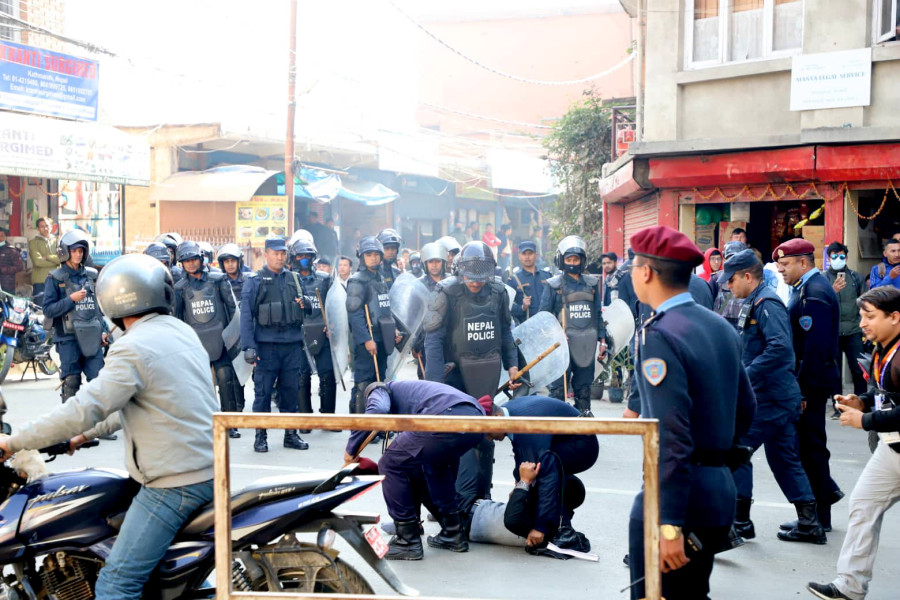National
Police want to be friends with the community but they act more like foes
Time and again, police quickly resort to baton charges and physical violence to deal with protests, even when unnecessary.
Anup Ojha
The disproportionate use of force by the Nepal Police to disperse school students and locals in Kohalpur has drawn widespread criticism on social media and the public sphere. Images of the police baton-charging students in school uniforms have been widely shared and just as widely condemned, with many drily asking if this is what the Nepal Police meant when they began their ‘police, my friend’ campaign.
On Sunday, after a truck hit 12-year-old Prakriti Chand in Banke’s Kohalpur and crushed her legs, irate students began to pelt the truck with stones. Police arrived, only to chase the students into the school and drag them out, further incensing students and locals. As the situation spiralled, police resorted to hundreds of rubber bullets, tear gas and countless baton charges on school students. Over two dozen people, including students, teachers and locals, were injured in the incident while 30 police officers were also injured.
हरि भएकोलाई हरि भनिन्छ, हरि नभएकोलाई प्रहरी। भर्त्सना ! pic.twitter.com/JPq1EXbBDO
— अक्षर काका (@aksharkaka) December 8, 2019
“Instead of taking the situation under control, the police provoked the students and showed their brutality,” Yubraj Paudel, a Kohalpur local who witnessed the incident, told the Post over the phone. “The students were understandably angry seeing their friend badly injured. The incident turned more violent after the police entered the school and started to thrash teachers and students.”
Three years ago, on July 11, 2016, the Nepal Police had started their nationwide ‘prahari mero sathi’ (police, my friend) campaign in order to salvage their tarnished image. But if the Kohalpur incident is anything to go by, the police’s campaign either has not permeated down to the rank-and-file or the commanding officers are themselves disregarding their duties, say rights activists.
“They come up with attractive slogans and a proper policy but nothing is implemented at the ground level,” said human rights activist Charan Prasain. “Students and schools are sensitive areas, and the police entering into schools and manhandling students is beyond the Nepal Police’s jurisdiction.”
दर्शकलाई रंगशालामा प्रहरीकाे किक हेर्नुस !pic.twitter.com/SkVxrDqbax
— ShIvA DaHaL (@dahalshivaji) December 10, 2019
Time and again, the Nepal Police appears quick to resort to batons, even when protests pose little to no risk to them. On Tuesday, images once again appeared on social media of a police officer kicking a protester who had already been taken into custody from outside the Dashrath Stadium in Kathmandu. Protests had broken out after fans were unable to get tickets for the South Asian Games football finals between Nepal and Bhutan. The police had quickly taken to baton charges, even attacking a journalist.
“That was a blatant use of excessive force by Nepal Police. Police kicked and thrashed a photojournalist and chased media persons who were taking pictures,” said Hari Raj Sapkota, who came all the way from Parbat to watch the final game.
There are numerous such incidents of the Nepal Police using excessive force to disperse citizens.
In August last year, one person was killed and 24 injured in Kanchanpur after police resorted to force when protesters took to the streets over the unresolved rape and murder case of Nirmala Pant. Similarly, last year, police used disproportionate force at a hospital in Jumla against supporters of orthopaedic surgeon Dr Govinda KC. More recently, in June, police had used similar tactics to disperse heritage conservationists and locals who were peacefully protesting the government proposed Guthi Bill. Half a dozen protesters were injured.
According to former deputy inspector general Hemant Malla Thakuri, the primary reason behind the police using excessive force is the rank-and-file’s inability to read mob psychology while attempting to controlling a protest.
“Most commanders assigned to control mobs lack the capacity to read mass psychology. If only the in-charge has that ability, casualties can be controlled,” said Thakuri. “Just a few months of training can’t change police behaviour, as they too are products of society.”
The Nepal Police also lacks proper soft equipment, such as water cannons and tear gas, to control protests and mobs, he said. Water cannons are only available in big cities and police often do not have enough tear gas to disperse crowds.
While Thakuri acknowledged that the police do tend to resort quickly to hard power when confronted with a large mass of people, Nepal Police spokesperson Deputy Inspector General Bishwaraj Pokharel said that police only resort to force as a last resort.
“Police use force at the last moment to safeguard the life and property of the public. Social media and Youtube show only one side of the story,” said Pokharel. “But we are getting more serious regarding these issues.”




 7.47°C Kathmandu
7.47°C Kathmandu.jpg)










%20(1).jpg&w=300&height=200)




